2008 NISSAN TEANA check oil
[x] Cancel search: check oilPage 4397 of 5121
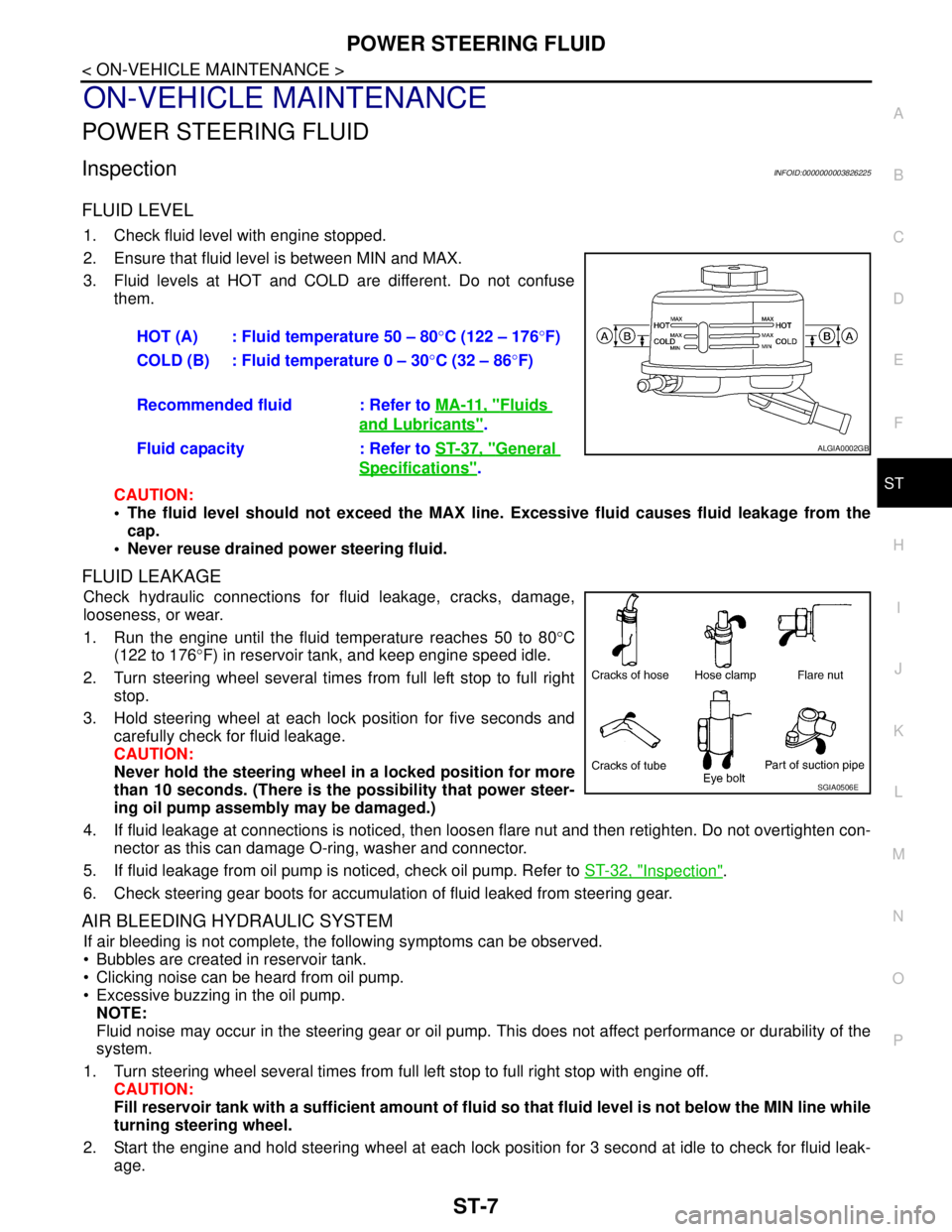
POWER STEERING FLUID
ST-7
< ON-VEHICLE MAINTENANCE >
C
D
E
F
H
I
J
K
L
MA
B
ST
N
O
P
ON-VEHICLE MAINTENANCE
POWER STEERING FLUID
InspectionINFOID:0000000003826225
FLUID LEVEL
1. Check fluid level with engine stopped.
2. Ensure that fluid level is between MIN and MAX.
3. Fluid levels at HOT and COLD are different. Do not confuse
them.
CAUTION:
The fluid level should not exceed the MAX line. Excessive fluid causes fluid leakage from the
cap.
Never reuse drained power steering fluid.
FLUID LEAKAGE
Check hydraulic connections for fluid leakage, cracks, damage,
looseness, or wear.
1. Run the engine until the fluid temperature reaches 50 to 80°C
(122 to 176°F) in reservoir tank, and keep engine speed idle.
2. Turn steering wheel several times from full left stop to full right
stop.
3. Hold steering wheel at each lock position for five seconds and
carefully check for fluid leakage.
CAUTION:
Never hold the steering wheel in a locked position for more
than 10 seconds. (There is the possibility that power steer-
ing oil pump assembly may be damaged.)
4. If fluid leakage at connections is noticed, then loosen flare nut and then retighten. Do not overtighten con-
nector as this can damage O-ring, washer and connector.
5. If fluid leakage from oil pump is noticed, check oil pump. Refer to ST-32, "
Inspection".
6. Check steering gear boots for accumulation of fluid leaked from steering gear.
AIR BLEEDING HYDRAULIC SYSTEM
If air bleeding is not complete, the following symptoms can be observed.
Bubbles are created in reservoir tank.
Clicking noise can be heard from oil pump.
Excessive buzzing in the oil pump.
NOTE:
Fluid noise may occur in the steering gear or oil pump. This does not affect performance or durability of the
system.
1. Turn steering wheel several times from full left stop to full right stop with engine off.
CAUTION:
Fill reservoir tank with a sufficient amount of fluid so that fluid level is not below the MIN line while
turning steering wheel.
2. Start the engine and hold steering wheel at each lock position for 3 second at idle to check for fluid leak-
age.HOT (A) : Fluid temperature 50 – 80°C (122 – 176°F)
COLD (B) : Fluid temperature 0 – 30°C (32 – 86°F)
Recommended fluid : Refer to MA-11, "
Fluids
and Lubricants".
Fluid capacity : Refer to ST-37, "
General
Specifications".
ALGIA0002GB
SGIA0506E
Page 4398 of 5121

ST-8
< ON-VEHICLE MAINTENANCE >
POWER STEERING FLUID
3. Repeat step 2 above several times at approximately 3 second intervals.
CAUTION:
Never hold the steering wheel in a locked position for more than 10 seconds. (There is the possi-
bility that oil pump may be damaged.)
4. Check fluid for bubbles and white contamination.
5. Stop the engine if bubbles and white contamination do not drain out. Perform step 2 and 3 above after
waiting until bubbles and white contamination drain out.
6. Stop the engine, and then check fluid level.
Page 4400 of 5121
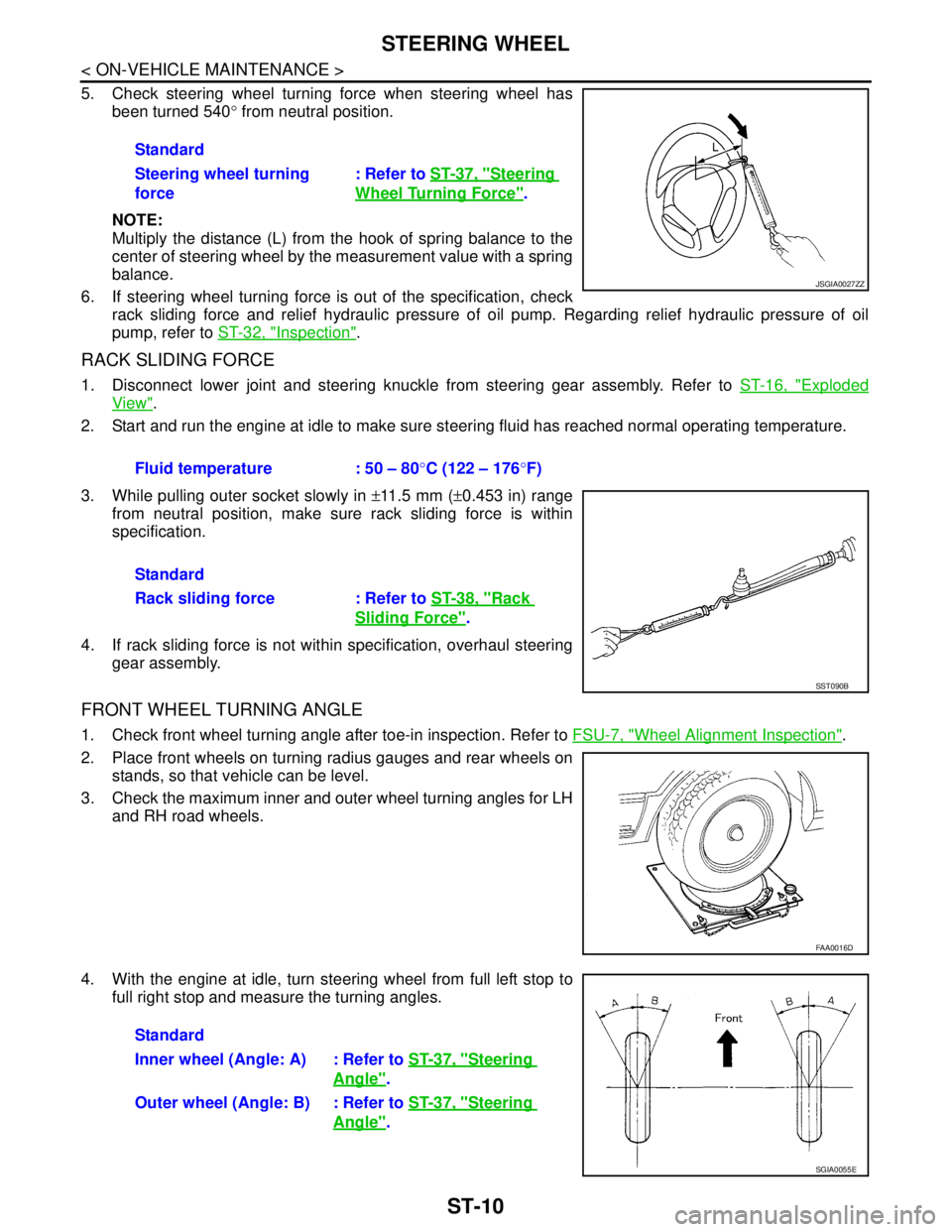
ST-10
< ON-VEHICLE MAINTENANCE >
STEERING WHEEL
5. Check steering wheel turning force when steering wheel has
been turned 540° from neutral position.
NOTE:
Multiply the distance (L) from the hook of spring balance to the
center of steering wheel by the measurement value with a spring
balance.
6. If steering wheel turning force is out of the specification, check
rack sliding force and relief hydraulic pressure of oil pump. Regarding relief hydraulic pressure of oil
pump, refer to ST-32, "
Inspection".
RACK SLIDING FORCE
1. Disconnect lower joint and steering knuckle from steering gear assembly. Refer to ST-16, "Exploded
View".
2. Start and run the engine at idle to make sure steering fluid has reached normal operating temperature.
3. While pulling outer socket slowly in ±11.5 mm (±0.453 in) range
from neutral position, make sure rack sliding force is within
specification.
4. If rack sliding force is not within specification, overhaul steering
gear assembly.
FRONT WHEEL TURNING ANGLE
1. Check front wheel turning angle after toe-in inspection. Refer to FSU-7, "Wheel Alignment Inspection".
2. Place front wheels on turning radius gauges and rear wheels on
stands, so that vehicle can be level.
3. Check the maximum inner and outer wheel turning angles for LH
and RH road wheels.
4. With the engine at idle, turn steering wheel from full left stop to
full right stop and measure the turning angles.Standard
Steering wheel turning
force: Refer to ST-37, "
Steering
Wheel Turning Force".
JSGIA0027ZZ
Fluid temperature : 50 – 80°C (122 – 176°F)
Standard
Rack sliding force : Refer to ST-38, "
Rack
Sliding Force".
SST090B
FAA0016D
Standard
Inner wheel (Angle: A) : Refer to ST-37, "
Steering
Angle".
Outer wheel (Angle: B) : Refer to ST-37, "
Steering
Angle".
SGIA0055E
Page 4419 of 5121
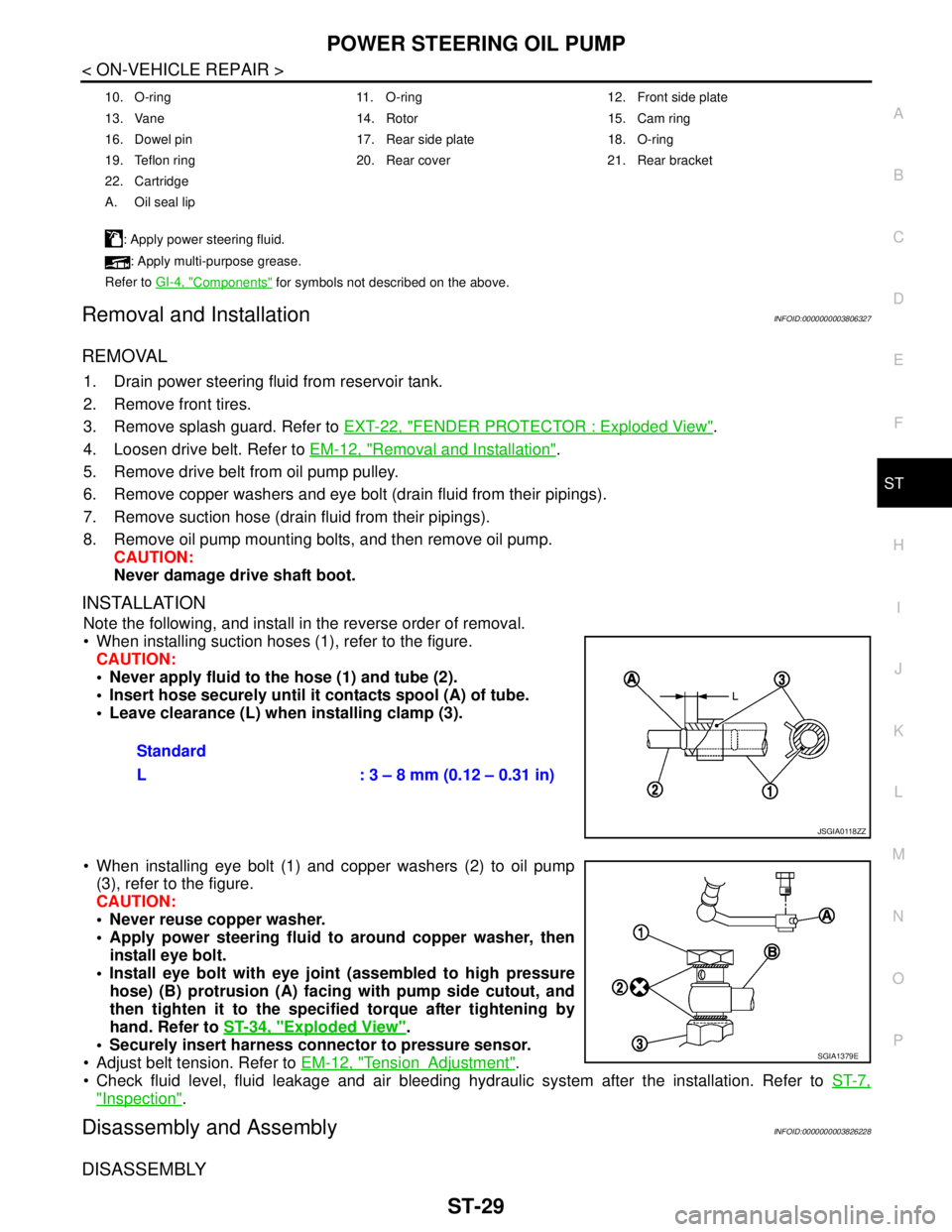
POWER STEERING OIL PUMP
ST-29
< ON-VEHICLE REPAIR >
C
D
E
F
H
I
J
K
L
MA
B
ST
N
O
P
Removal and InstallationINFOID:0000000003806327
REMOVAL
1. Drain power steering fluid from reservoir tank.
2. Remove front tires.
3. Remove splash guard. Refer to EXT-22, "
FENDER PROTECTOR : Exploded View".
4. Loosen drive belt. Refer to EM-12, "
Removal and Installation".
5. Remove drive belt from oil pump pulley.
6. Remove copper washers and eye bolt (drain fluid from their pipings).
7. Remove suction hose (drain fluid from their pipings).
8. Remove oil pump mounting bolts, and then remove oil pump.
CAUTION:
Never damage drive shaft boot.
INSTALLATION
Note the following, and install in the reverse order of removal.
When installing suction hoses (1), refer to the figure.
CAUTION:
Never apply fluid to the hose (1) and tube (2).
Insert hose securely until it contacts spool (A) of tube.
Leave clearance (L) when installing clamp (3).
When installing eye bolt (1) and copper washers (2) to oil pump
(3), refer to the figure.
CAUTION:
Never reuse copper washer.
Apply power steering fluid to around copper washer, then
install eye bolt.
Install eye bolt with eye joint (assembled to high pressure
hose) (B) protrusion (A) facing with pump side cutout, and
then tighten it to the specified torque after tightening by
hand. Refer to ST-34, "
Exploded View".
Securely insert harness connector to pressure sensor.
Adjust belt tension. Refer to EM-12, "
TensionAdjustment".
Check fluid level, fluid leakage and air bleeding hydraulic system after the installation. Refer to ST-7,
"Inspection".
Disassembly and AssemblyINFOID:0000000003826228
DISASSEMBLY
10. O-ring 11. O-ring 12. Front side plate
13. Vane 14. Rotor 15. Cam ring
16. Dowel pin 17. Rear side plate 18. O-ring
19. Teflon ring 20. Rear cover 21. Rear bracket
22. Cartridge
A. Oil seal lip
: Apply power steering fluid.
: Apply multi-purpose grease.
Refer to GI-4, "
Components" for symbols not described on the above.
Standard
L : 3 – 8 mm (0.12 – 0.31 in)
JSGIA0118ZZ
SGIA1379E
Page 4423 of 5121
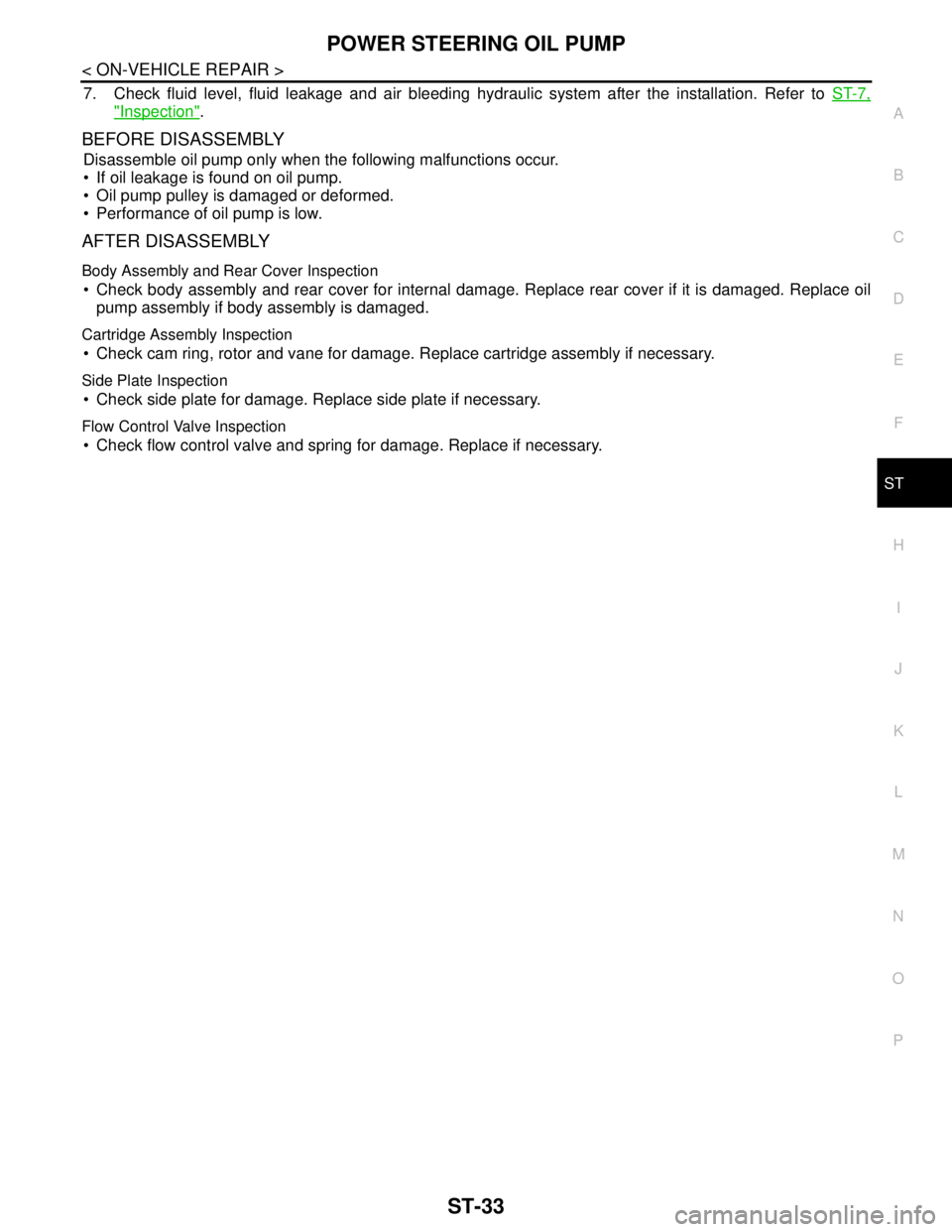
POWER STEERING OIL PUMP
ST-33
< ON-VEHICLE REPAIR >
C
D
E
F
H
I
J
K
L
MA
B
ST
N
O
P
7. Check fluid level, fluid leakage and air bleeding hydraulic system after the installation. Refer to ST-7,
"Inspection".
BEFORE DISASSEMBLY
Disassemble oil pump only when the following malfunctions occur.
If oil leakage is found on oil pump.
Oil pump pulley is damaged or deformed.
Performance of oil pump is low.
AFTER DISASSEMBLY
Body Assembly and Rear Cover Inspection
Check body assembly and rear cover for internal damage. Replace rear cover if it is damaged. Replace oil
pump assembly if body assembly is damaged.
Cartridge Assembly Inspection
Check cam ring, rotor and vane for damage. Replace cartridge assembly if necessary.
Side Plate Inspection
Check side plate for damage. Replace side plate if necessary.
Flow Control Valve Inspection
Check flow control valve and spring for damage. Replace if necessary.
Page 4430 of 5121
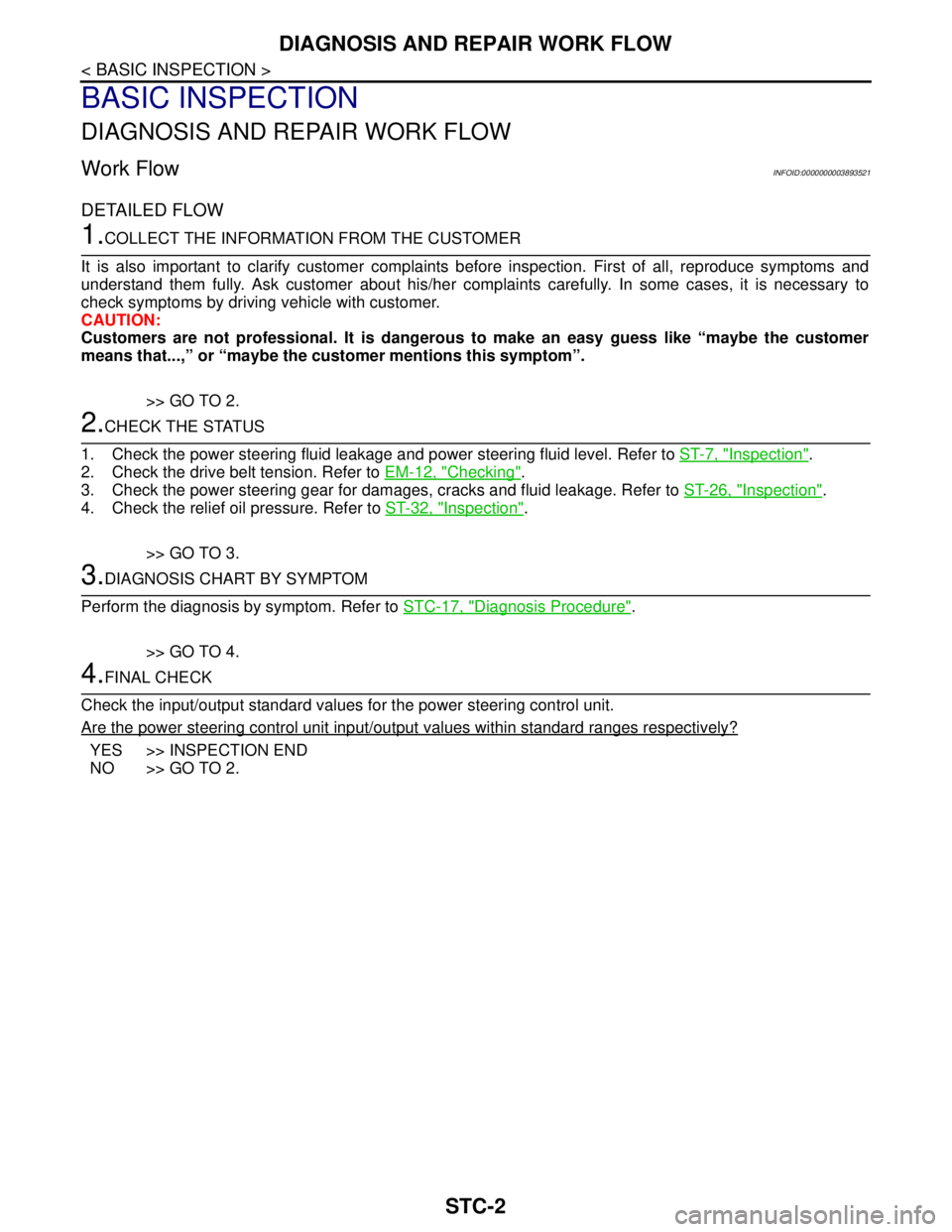
STC-2
< BASIC INSPECTION >
DIAGNOSIS AND REPAIR WORK FLOW
BASIC INSPECTION
DIAGNOSIS AND REPAIR WORK FLOW
Work FlowINFOID:0000000003893521
DETAILED FLOW
1.COLLECT THE INFORMATION FROM THE CUSTOMER
It is also important to clarify customer complaints before inspection. First of all, reproduce symptoms and
understand them fully. Ask customer about his/her complaints carefully. In some cases, it is necessary to
check symptoms by driving vehicle with customer.
CAUTION:
Customers are not professional. It is dangerous to make an easy guess like “maybe the customer
means that...,” or “maybe the customer mentions this symptom”.
>> GO TO 2.
2.CHECK THE STATUS
1. Check the power steering fluid leakage and power steering fluid level. Refer to ST-7, "
Inspection".
2. Check the drive belt tension. Refer to EM-12, "
Checking".
3. Check the power steering gear for damages, cracks and fluid leakage. Refer to ST-26, "
Inspection".
4. Check the relief oil pressure. Refer to ST-32, "
Inspection".
>> GO TO 3.
3.DIAGNOSIS CHART BY SYMPTOM
Perform the diagnosis by symptom. Refer to STC-17, "
Diagnosis Procedure".
>> GO TO 4.
4.FINAL CHECK
Check the input/output standard values for the power steering control unit.
Are the power steering control unit input/output values within standard ranges respectively?
YES >> INSPECTION END
NO >> GO TO 2.
Page 4435 of 5121

POWER STEERING SOLENOID VALVE
STC-7
< COMPONENT DIAGNOSIS >
C
D
E
F
H
I
J
K
L
MA
B
STC
N
O
P
POWER STEERING SOLENOID VALVE
DescriptionINFOID:0000000003893528
Power steering solenoid valve controls the power steering oil pressure in the gear housing assembly.
Diagnosis ProcedureINFOID:0000000003893529
1.CHECK POWER STEERING SOLENOID VALVE SIGNAL
1. Turn the ignition switch OFF.
2. Check voltage between power steering control unit harness connector and ground.
Is the inspection result normal?
YES >> GO TO 2.
NO >> GO TO 4.
2.CHECK HARNESS BETWEEN POWER STEERING SOLENOID VALVE AND POWER STEERING CON-
TROL UNIT
1. Turn the ignition switch OFF.
2. Disconnect power steering solenoid valve harness connector.
3. Disconnect power steering control unit harness connector.
4. Check the continuity between power steering solenoid valve harness connector and the power steering
control unit harness connector.
5. Check continuity between power steering control unit harness connector and ground.
Is the inspection result normal?
YES >> GO TO 3.
NO >> Repair or replace damaged parts.
3.CHECK POWER STEERING SOLENOID VALVE
Check power steering solenoid valve. Refer to STC-8, "
Component Inspection".
Is the inspection result normal?
YES >> GO TO 4.
NO >> Replace gear-sub assembly. Refer to ST-18, "
Exploded View".
4.CHECK TERMINALS AND HARNESS CONNECTORS
Check power steering control unit pin terminals for damage or loose connection with harness connector.
Check power steering solenoid valve pin terminals for damage or loose connection with harness connector.
Is the inspection result normal?
Power steering control unit
— Condition Voltage (Approx.)
Connector Terminal
M61 1 GroundVehicle speed: 0 km/h (0 MPH)
(Engine is running)4.4 – 6.6 V
Vehicle speed: 100 km/h (62 MPH) 2.4 – 3.6 V
Power steering solenoid valve Power steering control unit
Continuity
Connector Terminal Connector Terminal
E52 1 M61 1 Existed
E52 2 M61 5 Existed
Power steering control unit
—Continuity
Connector Terminal
M61 1
Ground Not existed
M61 5
Page 4477 of 5121

TM-4
ROAD TEST .....................................................148
Description .............................................................148
Check before Engine Is Started .............................148
Check at Idle ..........................................................149
Cruise Test ............................................................150
CVT POSITION ................................................152
Inspection and Adjustment ....................................152
ON-VEHICLE REPAIR ...............................153
TRANSMISSION CONTROL MODULE ..........153
Exploded View .......................................................153
Removal and Installation .......................................153
Adjustment .............................................................154
CONTROL DEVICE .........................................155
Exploded View .......................................................155
Removal and Installation .......................................155
Inspection and Adjustment ....................................156
CONTROL CABLE ..........................................157
Exploded View .......................................................157
Removal and Installation .......................................157
Inspection and Adjustment ....................................158
OIL PAN ...........................................................159
Exploded View .......................................................159
Removal and Installation .......................................159
Inspection ..............................................................160
SECONDARY SPEED SENSOR .....................161
Exploded View .......................................................161
Removal and Installation .......................................161
Inspection ..............................................................161
DIFFERENTIAL SIDE OIL SEAL ....................162
Exploded View .......................................................162
Removal and Installation .......................................162
Inspection ..............................................................163
AIR BREATHER HOSE ...................................164
Exploded View .......................................................164
Removal and Installation .......................................164
FLUID COOLER SYSTEM ...............................165
Exploded View .......................................................165
Removal and Installation .......................................165
Inspection ..............................................................167
REMOVAL AND INSTALLATION ..............168
TRANSAXLE ASSEMBLY ..............................168
Exploded View .......................................................168
Removal and Installation .......................................168
Inspection ..............................................................170
DISASSEMBLY AND ASSEMBLY ............172
TORQUE CONVERTER ..................................172
Exploded View .......................................................172
Disassembly ..........................................................172
Assembly ..............................................................172
Inspection ..............................................................173
SERVICE DATA AND SPECIFICATIONS
(SDS) .........................................................
174
SERVICE DATA AND SPECIFICATIONS
(SDS) ................................................................
174
General Specification ............................................174
Vehicle Speed When Shifting Gears .....................174
Stall Speed ............................................................174
Line Pressure ........................................................174
Solenoid Valves ....................................................175
CVT Fluid Temperature Sensor ............................175
Primary Speed Sensor ..........................................175
Secondary Speed Sensor .....................................175
Step Motor ............................................................175
Torque Converter ..................................................175
CVT: RE0F10A
BASIC INSPECTION .................................
176
DIAGNOSIS AND REPAIR WORK FLOW .......176
Work Flow .............................................................176
Diagnostic Work Sheet .........................................177
INSPECTION AND ADJUSTMENT ..................179
ADDITIONAL SERVICE WHEN REPLACING
CONTROL UNIT ......................................................
179
ADDITIONAL SERVICE WHEN REPLACING
CONTROL UNIT : Service After Replacing TCM
and Transaxle Assembly .......................................
179
FUNCTION DIAGNOSIS ...........................181
CVT SYSTEM ...................................................181
System Diagram ...................................................181
Component Parts Location ...................................182
MECHANICAL SYSTEM ..................................183
Cross-Sectional View ............................................183
System Diagram ...................................................184
System Description ...............................................184
Component Parts Location ...................................185
Component Description ........................................186
HYDRAULIC CONTROL SYSTEM ..................187
System Diagram ...................................................187
System Description ...............................................187
Component Parts Location ...................................188
Component Description ........................................189
CONTROL SYSTEM .........................................190
System Diagram ...................................................190
System Description ...............................................190
Component Parts Location ...................................192
Component Description ........................................193
LOCK-UP AND SELECT CONTROL SYSTEM
..
194